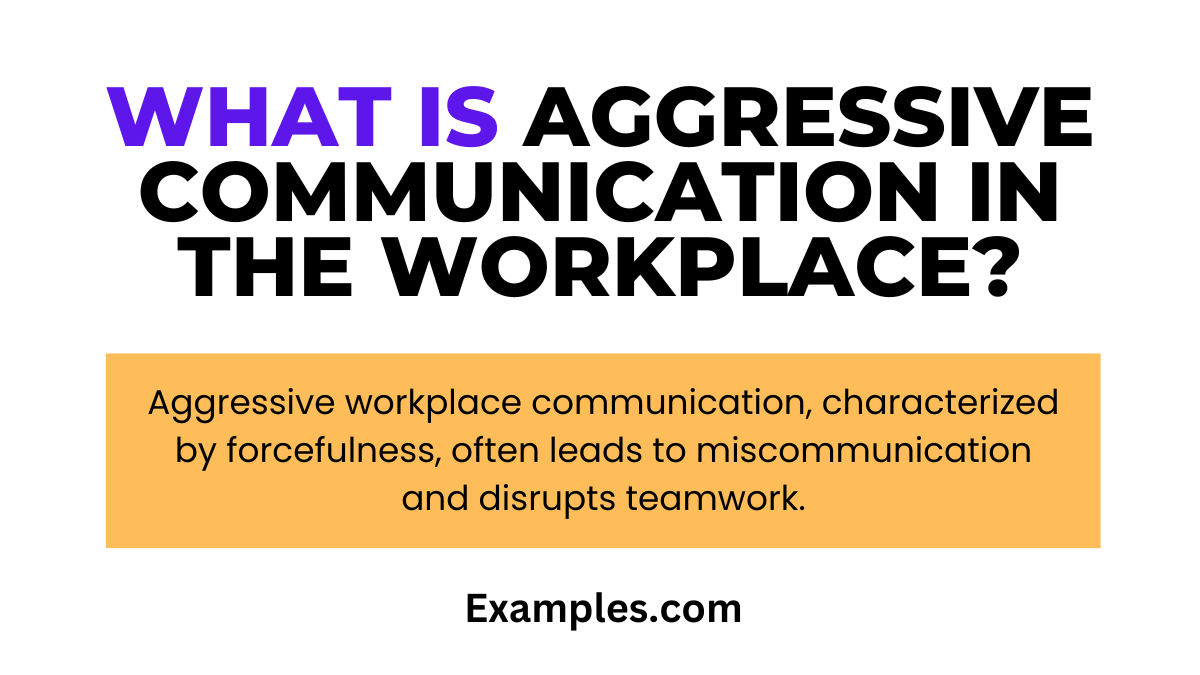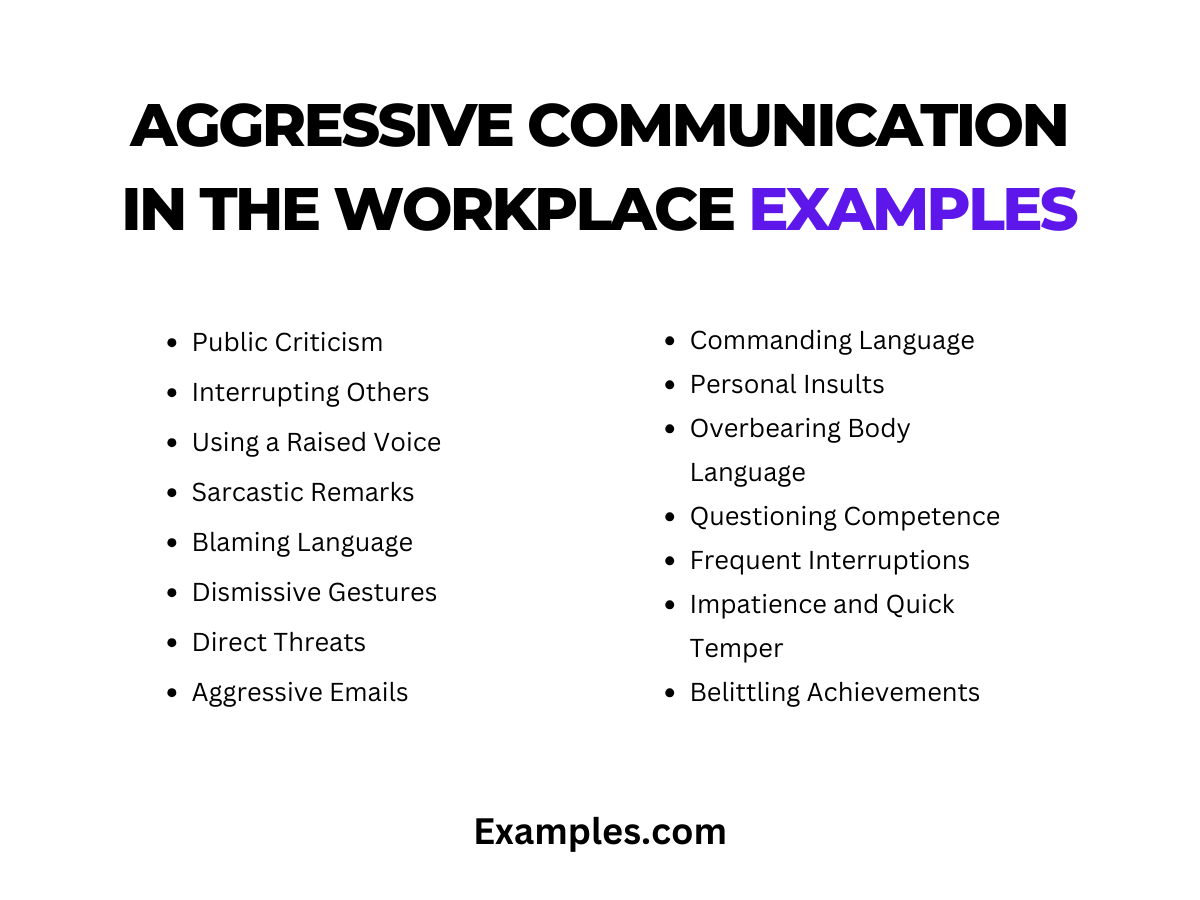14+ Aggressive Communication in the Workplace Examples
This guide delves into the complex world of Aggressive Communication in the Workplace, providing a nuanced understanding and practical examples. While often perceived negatively, recognizing and understanding aggressive communication is crucial for maintaining Effective Communication and a harmonious work environment. This guide not only identifies examples of aggressive communication but also offers strategies to respond constructively. Emphasizing the importance of maintaining a Passive and composed approach, it aims to equip readers with the skills to navigate challenging workplace interactions, enhancing their Interpersonal Communication and conflict-resolution abilities.
What is Aggressive Communication in the Workplace?

Aggressive Communication in the Workplace is a communication style characterized by a forceful, dominating approach often perceived as hostile or overly assertive. This type of communication can involve direct verbal statements, a raised tone of voice, or nonverbal cues indicating aggression. While it may sometimes stem from a desire to be heard or assert authority, aggressive communication often leads to Miscommunication and a negative work atmosphere, hindering Effective Communication and team collaboration.
15 Aggressive Communication in the Workplace Examples

- Public Criticism: Criticizing someone openly in front of others, often in a demeaning tone.
Example: “This report is completely inadequate; how could you think this was acceptable?” - Interrupting Others: Consistently interrupting colleagues during meetings, showing a lack of respect for their input.
Example: Cutting off a colleague mid-sentence, “That’s enough, let me tell you the right way.” - Using a Raised Voice: Raising one’s voice to dominate a conversation or a meeting.
Example: “I don’t care what you think! We’re doing it my way!” - Sarcastic Remarks: Employing sarcasm in a way that belittles or undermines colleagues.
Example: “Great job on that project, just like everything else you do.” - Blaming Language: Pointing fingers and assigning blame without considering all factors.
Example: “This is all your fault; you’ve ruined the project!” - Dismissive Gestures: Using nonverbal cues like eye-rolling or scoffing to dismiss others’ ideas.
Example: Eye-rolling while a colleague presents an idea. - Direct Threats: Making threats to enforce authority or coerce others.
Example: “If you don’t get this done, you can forget about your job security.” - Aggressive Emails: Sending emails with an aggressive tone, often marked by harsh language or ultimatums.
Example: “This is the last time I’m going to tell you to get your act together!” - Personal Insults: Attacking someone’s character or abilities in a workplace setting.
Example: “You’re just too incompetent to understand this.” - Commanding Language: Using imperatives that imply a lack of choice or agency for the listener.
Example: “You will stay late tonight and finish this, no excuses.” - Overbearing Body Language: Dominating physical space in an intimidating manner.
Example: Standing too close or leaning over someone while talking. - Questioning Competence: Openly questioning someone’s ability to perform their job.
Example: “Are you even qualified to handle this task?” - Frequent Interruptions: Not allowing others to speak or express their ideas fully.
Example: Constantly interrupting a presentation with critical remarks. - Impatience and Quick Temper: Showing little tolerance for questions or mistakes.
Example: “I don’t have time to babysit you through every little step!” - Belittling Achievements: Undermining or trivializing colleagues’ accomplishments.
Example: “That project you completed? Anyone could have done it.”
What are the Examples of Aggressive Communication in the Workplace?

- Public Reprimands: Criticizing or reprimanding an employee in front of their colleagues, which can create a hostile work environment and damage Morale.
- Overbearing Instructions: Giving orders in a commanding tone, implying a lack of respect for the recipient’s professional autonomy, often hindering Effective Communication.
- Dismissive Attitudes: Showing a lack of regard for others’ ideas or contributions, which can stifle Creative Thinking and collaborative efforts.
- Personal Insults or Remarks: Attacking an individual’s character or work, rather than focusing on constructive feedback, leading to Workplace Conflict.
- Intimidating Body Language: Using physical presence to dominate discussions, such as standing too close or pointing fingers, which can create an uncomfortable atmosphere.
- Hostile Email Communication: Sending emails with aggressive tones, often marked by caps lock usage or demanding language, reflecting poor Email Etiquette.
- Unwarranted Blame: Assigning blame without understanding the situation fully, often leading to unfair accusations and Miscommunication.
- Threatening Job Security: Using one’s position to threaten an employee’s job as a means of getting tasks done, which can create a culture of fear.
How Do You Respond to Aggressive Communication in the Workplace?

Responding effectively to aggressive communication in the workplace is essential for maintaining professionalism and a positive work environment. Here are strategies to deal with such situations:
- Maintain Composure: Stay calm and composed. Reacting aggressively can escalate the situation, so it’s important to practice Self-Control.
- Use Active Listening: Listen to understand the concerns behind the aggressive behavior. This can sometimes de-escalate the tension and lead to more Productive Conversations.
- Set Boundaries: Politely but firmly set boundaries if the communication becomes disrespectful. It’s important to advocate for a respectful Workplace Culture.
- Seek Clarification: Ask clarifying questions to understand the root cause of the aggression. This can aid in resolving the underlying issue and improve Workplace Communication.
- Address the Issue Privately: If possible, address the issue in a private setting. Directly but respectfully discuss how the aggressive communication affects work and morale.
- Use ‘I’ Statements: Express your feelings and perspective using ‘I’ statements to avoid sounding accusatory, which is a key aspect of Assertive Communication.
- Seek Support if Necessary: If the situation does not improve, or if it escalates, seek support from HR or higher management. It’s important to ensure that Employee Well-being is prioritized.
In summary, this guide on Aggressive Communication in the Workplace offers crucial insights into recognizing and effectively responding to aggressive behaviors in professional settings. Understanding these dynamics is key to fostering a respectful, productive work environment. By implementing these strategies, individuals and teams can navigate challenging interactions, promote Effective Communication, and contribute to a healthier, more collaborative workplace culture.



